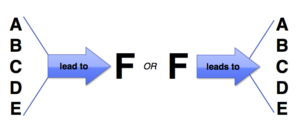Overview
This structure considers a topic as part of a larger active system of causation. The sermon may unfold the system of causation in one of three ways: naming the causes that lead to the topic; naming the effects that proceed from the topic; or analyzing the topic itself as embedded in a system of causation. For example, if the topic were hope, the preacher could enumerate the causes that lead to the topic (e.g., the causes of Christian hope) or the effects that proceed from the topic (e.g., the effects of hope upon Christian living) or the entire system of causes and effects (e.g., Christ’s promised return gives hope to Christian living).
In listing causes and effects, the preacher may consider a serial process of causation (e.g., suffering produces perseverance, perseverance produces character, character produces hope) or a parallel body of information (e.g., five promises of God that inspire Christian hope).


When working with serial causation, the preacher needs to be wary of a slippery slope argument. When working with a parallel body of information, the preacher needs to offer some indication of importance among these items (why they are listed in this sequence) and be wary of confusing causation with correlation.
